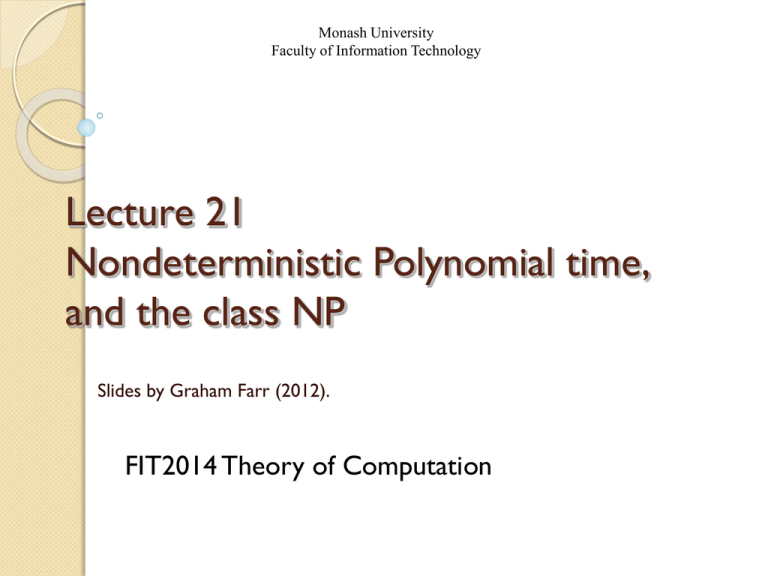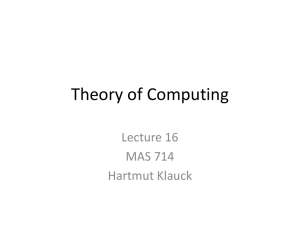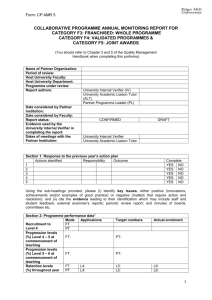Polynomial time and the class P
advertisement

Monash University
Faculty of Information Technology
Lecture 21
Nondeterministic Polynomial time,
and the class NP
Slides by Graham Farr (2012).
FIT2014 Theory of Computation
Overview
Deciding and Verifying
Certificate
The class NP
Proving membership of NP
Examples of languages in NP
P Í NP
The P-versus-NP problem
Deciders for languages in NP
Nondeterministic Polynomial-time Turing machines
Deciding and Verifying
Deciding if a string belongs to a language or not
versus
Verifying that a string belongs to a language
(if it does)
Deciding and Verifying
P is intended to contain languages which are
efficiently decidable
◦ i.e., you can efficiently solve the problem of deciding
whether something is in the language or not
Recall (Lecture 17, on Decidability):
A decider for a language L is a TM that
◦ halts for any input
◦ accepts every x in L
◦ rejects every x not in L
P is the set of languages for which there is a
polynomial-time decider.
Deciding and Verifying
Consider:
{ people who can kick a football }
◦ How do you verify that a person can kick a football?
◦ Give them a ball and get them to try to kick it.
◦ This procedure is a decider.
It enables you to decide whether or not they can kick a
football.
Deciding and Verifying
Now consider:
{ university graduates }
◦ How do you verify that a person is a graduate?
◦ Can’t do it just by meeting them, testing abilities etc.
There is no efficient decider for this set.
◦ But you can verify it if you have their degree certificate.
◦ Hard to verify that someone is not a graduate.
Deciding and Verifying
A verifier for a language L is a TM that takes, as
input, two strings x and y,
◦ halts for any x, y
◦ if x is in L, there exists y such that the TM accepts
◦ if x is not in L, every y makes the machine reject.
y is called a certificate
x is accepted if and only if it has a certificate
which can be verified.
Polynomial-time verifier: a verifier with time
complexity polynomial in length of x.
(i.e., O(|x|k), for some fixed k, where |x| denotes length of string x)
NP
NP is the set of languages for which there is a
polynomial-time verifier.
NP stands for
Non-deterministic Polynomial time
(for reasons to be given later)
NP is intended to contain languages for which
membership can be efficiently verified, with the
aid of an appropriate certificate.
Proving membership of NP
To show a language is in NP, you need to:
specify the certificate
give a polynomial-time verifier (as an algorithm)
prove that it is a verifier for the language
prove that it is polynomial time.
Proving membership of NP
Proof that { 3-colourable graphs } is in NP.
Given: graph G
Certificate: a function f : V(G) { Red, White, Black}
Verification:
For each edge uv of G
{
Look up f(u) and f(v).
// … these are the colours given to the endpoints u, v of this edge
Check that f(u) ≠ f(v).
If so, continue. If not, Reject and halt.
// … endpoints must get different colours
}
If loop completes with no edge rejected, then Accept and halt.
Proving membership of NP
Claim 1:
This is a verifier for { 3-colourable graphs}.
Proof:
G is in { 3-colourable graphs}
if and only if
there exists a function f : V(G) { Red, White, Black }
such that, for each edge uv, we have f(u) ≠ f(v)
if and only if
there exists a certificate such that our verifier accepts G.
End of proof of Claim 1
Proving membership of NP
Claim 2:
Verifier takes polynomial time, in size of input.
Proof:
Main loop: # iterations = # edges = m, say.
For each edge: look up each endpoint in the certificate.
Suppose certificate is given as a list of colours, one for
each vertex. The vertex gives the position in the list.
Looking up the colour of each endpoint takes O(n) time,
where n := # vertices.
Checking whether f(u) ≠ f(v) takes constant time.
So total time ≤ m . n . constant = O(mn).
So it takes polynomial time, in size of G.
End of proof of Claim 2.
Proving membership of NP
So we have proved that { 3-colourable graphs } is in NP.
Remarks:
Some of these time estimates are loose upper bounds.
Better estimates are often possible. (E.g., how long does it
take to look something up in an array of size n ?)
But if our objective is to show that something is in NP,
then all we need to show is that the time complexity of
verification is bounded above by a polynomial (i.e., O(nk),
for some fixed k ).
Some languages in NP
For each of the examples we give, ask:
What is the certificate?
How do you verify it?
Examples:
the set of 2-colourable graphs
the set of 3-colourable graphs
{ (G, k) : G is a k-colourable graph }
Some languages in NP
the set of composite numbers
◦ { x in N : there exist integers y, z such that
1 < y < x, 1 < z < x, and x = y . z }
SATISFIABILITY:
the set of satisfiable Boolean expressions
2-SAT
◦ exactly two literals in each clause
◦ see the end of the previous lecture
3-SAT
◦ exactly three literals in each clause
Some languages in NP
the set of Eulerian graphs
the set of Hamiltonian graphs
◦ A Hamiltonian circuit in a graph G is a circuit which
includes each vertex exactly once. (note: a circuit
doesn’t repeat any vertex or edge)
◦ A graph is Hamiltonian if it contains a Hamiltonian
circuit.
Some languages in NP
GRAPH ISOMORPHISM:
{ (G, H) : G is isomorphic to H }
G is isomorphic to H if there is a bijection
f : V(G) V(H) such that, for all u, v in V(G),
u is adjacent to v in G if and only if
f(u) is adjacent to f(v) in H.
We write: G ≅ H
Such a bijection is an isomorphism.
Informally: G and H are the same, apart from
renaming vertices.
GRAPH ISOMORPHISM (continued)
Alan
Turing
H
Huntingdale
Clayton
G
Westall
Emily
Brontë
J
Winston
Churchill
Queen
Elizabeth II
G≅H
/
Charlotte
Brontë
Anne
Brontë
G≅
/ J
/ J
H≅
Some languages in NP
VERTEX COVER:
{ (G, k) : G has a vertex cover of size ≤ k }
A vertex cover in a graph G = (V, E) is a set X of
vertices such that every edge has at least one endpoint
in X.
In this graph:
{a, b, c} is a vertex cover
{b, c} is a vertex cover
{a, b, c, d} is a vertex cover
{a, b} is NOT a vertex cover
a
c
b
d
Some languages in NP
INDEPENDENT SET:
{ (G, k) : G has an independent set of size ≥ k }
An independent set in a graph G = (V, E) is a set X of
vertices such that no edge has both endpoints in X.
In this graph:
{b} is an independent set
{a, d} is an independent set
{c, d} is NOT an independent set
What
is the relationship
between vertex covers
and independent sets?
a
c
b
d
Some languages in NP
CLIQUE:
{ (G, k) : G has a clique of size ≥ k }
A clique in a graph G = (V, E) is a set X of vertices
such that every pair of vertices in X are adjacent.
In this graph:
{a} is a clique
b
a
{a, b} is a clique
{a, b, c} is a clique
{a, b, d} is NOT a clique
What is the relationship
between independent sets
and cliques?
c
d
P and NP
Theorem
P
Í NP
Proof (outline).
For any L in P, there is a polynomial-time decider for L.
Turn this into a verifier:
Given string x, and any other string y as a certificate, we
just run the decider on x.
Accept if the decider accepts. Reject if the decider rejects.
So we ignore the certificate.
Then prove that this is a polynomial-time verifier for L.
End of proof
P and NP
Conjecture
P ≠ NP
The
biggest open problem in Computer Science.
One of the biggest open problems in Mathematics.
Fame and glory await the solver …
… and a Millennium Prize ($US 1 million) from the Clay
Mathematics Institute
http://www.claymath.org/millennium/
But be careful: many false solutions have appeared, and
continue to appear all the time.
P and NP
NP
In NP, not known to be in P:
SATISFIABILITY, 3-SAT,
HAMILTONIAN CIRCUIT,
3-COLOURABILITY,
VERTEX COVER,
INDEPENDENT SET, …
GRAPH ISOMORPHISM,
INTEGER FACTORISATION, …
In P:
P
2-SAT,
EULERIAN CIRCUIT,
2-COLOURABILITY,
PRIMES,
CONNECTED GRAPHS,
SHORTEST PATH,
Invertible matrices,
Context-free languages,
Regular languages, …
P and NP
If P=NP:
SATISFIABILITY, 3-SAT,
HAMILTONIAN CIRCUIT,
3-COLOURABILITY,
VERTEX COVER,
INDEPENDENT SET, …
GRAPH ISOMORPHISM,
INTEGER FACTORISATION, …
2-SAT,
EULERIAN CIRCUIT,
2-COLOURABILITY,
PRIMES,
CONNECTED GRAPHS,
SHORTEST PATH,
Invertible matrices,
Context-free languages,
Regular languages, …
P and NP
Theorem
Any language in NP can be decided in time
K
n
O(2
) for some K.
Idea of Proof.
Let L be any language in NP.
It has a polynomial-time verifier.
Construct from this a decider for L.
How?
Decider does an exhaustive search of all possible
certificates, to see if one of them gets the input accepted.
Prove it’s a decider for L, and has the claimed time
complexity.
P and NP
The decider for L in detail:
Input: x
For each certificate y:
Call verifier on input x, certificate y.
If it accepts, then accept, else continue.
Accept x if the verifier accepts for some y;
Reject x if the verifier rejects for every y.
Decider for L? Clear from definition of a verifier.
Time complexity? If verifier has time complexity O(nk),
then decider’s time complexity is O( (# certificates) . nk).
P and NP
So: how many certificates?
At first sight: looks like infinitely many!
BUT in t steps, a Turing machine can examine at most t
symbols in the certificate.
Our verifier has time complexity O(nk), which is ≤ c . nk
(for sufficiently large n). So this verifier sees ≤ c . nk
symbols in the certificate. Any symbols beyond that are
ignored.
Assuming our usual alphabet {a, b}, the number of
k
cn
certificates that need to be checked is ≤ 2
.
k k
cn
So, decider’s total time complexity is O(2
n ) .
P and NP
k k
cn
So, decider’s total time complexity is O(2
n ) .
This is dominated by the exponential part, and in fact you
can find a constant K a bit larger than k such that the
K
n
time complexity is O(2
).
So any language in NP can be decided in exponential time.
Nondeterministic Turing machines
All Turing machines so far have been deterministic
◦ i.e., for each state and symbol, there is just one transition.
So, for each state and for each symbol, the next
action is completely determined: there is a specific
next state, new symbol and direction. In fact, the
entire computation is completely determined by
the input.
In a nondeterministic Turing machine (NDTM): for a
given state and symbol, there may be more than
one possible transition. (Briefly mentioned in Lecture 14)
One input may lead to many possible computations.
Deterministic TMs are also NDTMs!
Nondeterministic Turing machines
The language accepted by a NDTM M is the set of
input strings for which some computation leads to
an Accept state.
A NDTM M is a decider for a language L if
◦ M halts on all inputs, and
◦ the language accepted by M is L.
A polynomial-time NDTM is a NDTM which, for
any input x and any computation, halts in time
O(|x|k), for some fixed k.
Nondeterministic Turing machines
Theorem
L is in NP if and only if
some polynomial-time NDTM is a decider for L.
Proof (outline):
( => )
Suppose L has a verifier with time complexity ≤ c nk .
Construct a NDTM M as follows. On input x, M generates
a string y of length c nk , nondeterministically, and then just
executes the verifier on x, y.
Nondeterministic Turing machines
( <= )
Let M be a polynomial-time NDTM that decides L.
Set up a way of encoding, as a string, the sequence of
choices made at the nondeterministic steps of a
computation. Use this string as a certificate …
End of proof
NP stands for Nondeterministic Polynomial time
Contrast with finite automata, where DFAs and NFAs
define the same class of languages.
Revision
Sipser, sections 7.2-7.3.






